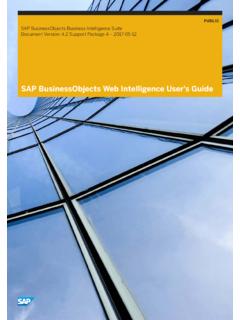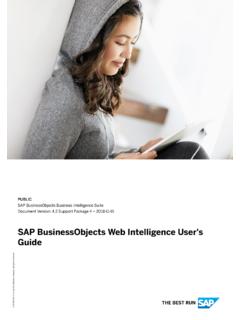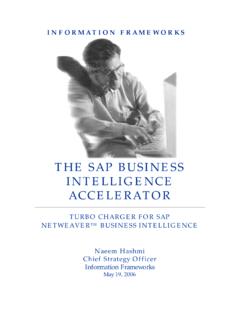Transcription of Business Objects Reports in BI Launchpad Quick Reference …
1 Business Objects Reports in BI Launchpad Quick Reference sheet report Types: There is only one type of report stored in BI Launchpad ; o Web intelligence (WebI) Reports (that can be edited if you have Interactive or Analyst access) o Desktop intelligence (DeskI) Reports are not supported in BI Launchpad When is Data Updated: For information on when data is updated check Starting Business Objects BI Launchpad : 1. Open the webpage: 2. Make sure the authentication is Windows AD 3. Enter your CNET username 4. Enter your CNET password 5. Click on the Logon button Finding Reports and Navigating in Folders: When you login to BI Launchpad you will start in the folder you selected in your preferences If not set, you can click on Folder expander under Document Tab In the lower left portion of the screen to display the current folder you can select the Folder you can access for Public folders Open a folder by double clicking on it or plus sign in front of it Documents and folders in the current folder are displayed on the right panel Standard report documents are stored in the Public Folder under.
2 O Public Folders Standard UCDW Reports FR-TT documents (Financial Reports ) HR documents (Human Resources Reports ) MatrixOBS documents (Financial Reports MatrixOBS Reports ) PAR documents (Payroll Reports ) Graduate Teaching Reports (SDW GAI/GTI Reports ) SDW Enroll Reg Reports (Student Enrollment/Registration Reports ) GEMS To IRF Reports (Expense Management Reports ) You will only see folders you have security to access You may have access to a divisional or Unit folder where documents created specifically for your Division/Unit have been stored Documents sent to you by other users will be in the My Documents | Inbox folder Creating a Shortcut to a Standard document: You can create a short cut to a report in your My Favorites by: 1. Right click on a standard report and select Organize| Create shortcut in My Favorites 2. Navigate to your My Favorites folder. Unlike InfoView, you do not need the extra step to paste, as the shortcut was pasted in step 1.
3 Running Reports : 1. Double click on the report name to open it 2. If the report doesn t auto refresh, click the Refresh Data icon on the toolbar 3. Click on a prompt and select or enter values to use to retrieve data. A Red arrow indicates a required value. A green checkmark will appear when a valid value(s) have been chosen. You can select multiple items (if appropriate) by holding down the Ctrl (individual selection) or Shift (range selection) key. Use the Arrow buttons to add or remove selected items. In Lists of items, you can also search for the value(s) you want. 4. IRF users: remember lucky number 7 for the SubAcct Rpt Grp Def prompt in most cases 5. Click the OK button (this will only show when values are selected for each prompt) Viewing & Navigating Reports : There are two View modes available, and the icons are just to the right of the page buttons, in the bottom right-hand corner of the screen.
4 Select the view mode by clicking View on the toolbar and then the mode desired on the dropdown list.; o Quick Display mode (default) allows for more information on a single page, use page buttons to move through report o Page mode used the layout for printing, use page buttons to move thru report If the report has more than one report tab, you will see multiple tabs across the bottom, much like worksheets in an Excel workbook. Navigate by clicking tab names. Business Objects Reports in BI Launchpad Quick Reference sheet Incidentally, there is a vertical slider button that allows you to jump from one tab to another. The Navigation Map will also show you the report tabs. If the report tab is sectioned, click the plus signs to open a section. To quickly jump within a click on the desired value. You can select the navigation map from the panel on the left hand side. The panel icons include: Document Summary Navigation Map Input Controls Available Objects Document Structure & Filters Finding Information in a report To find specific information within a report tab click on the binoculars icon on the toolbar (or Ctrl+F).
5 Print & Export Reports : o To print, click on the Print icon on the menu bar, which gives you two printing choices. o A PDF file of the entire report package will be generated, click the Open button to display the document in Adobe Acrobat reader. In Adobe Reader, click the Printer Icon or Select File | Print from the main menu as per a normal windows program. The other print option, click the down arrow, and then the Button. This will allow you to customize your export to PDF. You are presented with another dialog that allows options for your print routine. You can specify the following. Print Range: Page Size: Scaling & Orientation: Business Objects Reports in BI Launchpad Quick Reference sheet After choosing your settings, click the Print Button and you will get an option to either Save the PDF for later, or to open the PDF document for printing. Click the Open button to display the document in Adobe Acrobat reader.
6 In Adobe Reader, click the Printer Icon or Select File | Print from the main menu as per a normal windows program. To export, click on the export icon on the toolbar and select Export Document As (to save the entire package of Reports ) or Export Current report As (to save only the current report tab). o You can then select; Excel (.XLSX or .XLS format), PDF format or CSV Archive (comma delimited values), and Text. Using Simple report Filters: Turn on the report filter toolbar Click on the Add Filter Icon Select the item to filter on Pick the value (s) you want to see, or remove to discard You can create multiple filters or change them Cautions; o You can select filters that will display no data o For personal copies of Reports , filters are saved with the report Web Browser Security BI Launchpad uses pop-ups, so you will want to either turn off your pop-up blocker or tell it to allow pop-ups for the BI Launchpad site.
7 When using Microsoft IE you can also bypass pop-up (and file download) security by holding down the Ctrl button on the keyboard when you click on a hyperlink or file download. If you do not bypass security or allow pop-ups for BI Launchpad , you will be returned to the main screen when you click on a hyperlink in a report or try to download a file. Setting Preferences: On the right side of the InfoView toolbar click on the Preferences button When setting preferences, we are only concerned with two items: General and Web intelligence . Under Preference General Select a starting folder; 1. Under General settings, if Use Default Settings is checked, uncheck the box. Under Set BI Launch Pad Start Page, you can select the radio button for Document tab, which will select the My Documents, My Favorites combo by default, though you can change this by selecting an alternate radio button. 2. If you would like to select a folder other than the My Favorites folder, select the Folders radio button and if you would like a folder other than the default of Public Folders, click the Select Public Folder radio button to browse to the folder of your choice.
8 3. Navigate to the folder you want to start in (typically a standard document folder, a divisional folder or you My Favorites) and click the OK button Turn off all Document Tabs, except Type (Recommended) Under Preferences Web intelligence , the following settings are recommended: Business Objects Reports in BI Launchpad Quick Reference sheet Getting Help: Select the Help report tab and click on the help links for information on the document, other documents in the subject area and information about the subject area Search the knowledge base Use the keyword Business Objects and then the type of report IRF , GEMS or SDW Add the keyword Training to find documentation, training videos and to register for training classes For IRF Reports email For SDW Reports email For GEMS To IRF Reports email For AURA Reports email G:\devel\IRF\IRF2 application roll-out\Support\InfoView Quick Reference .









